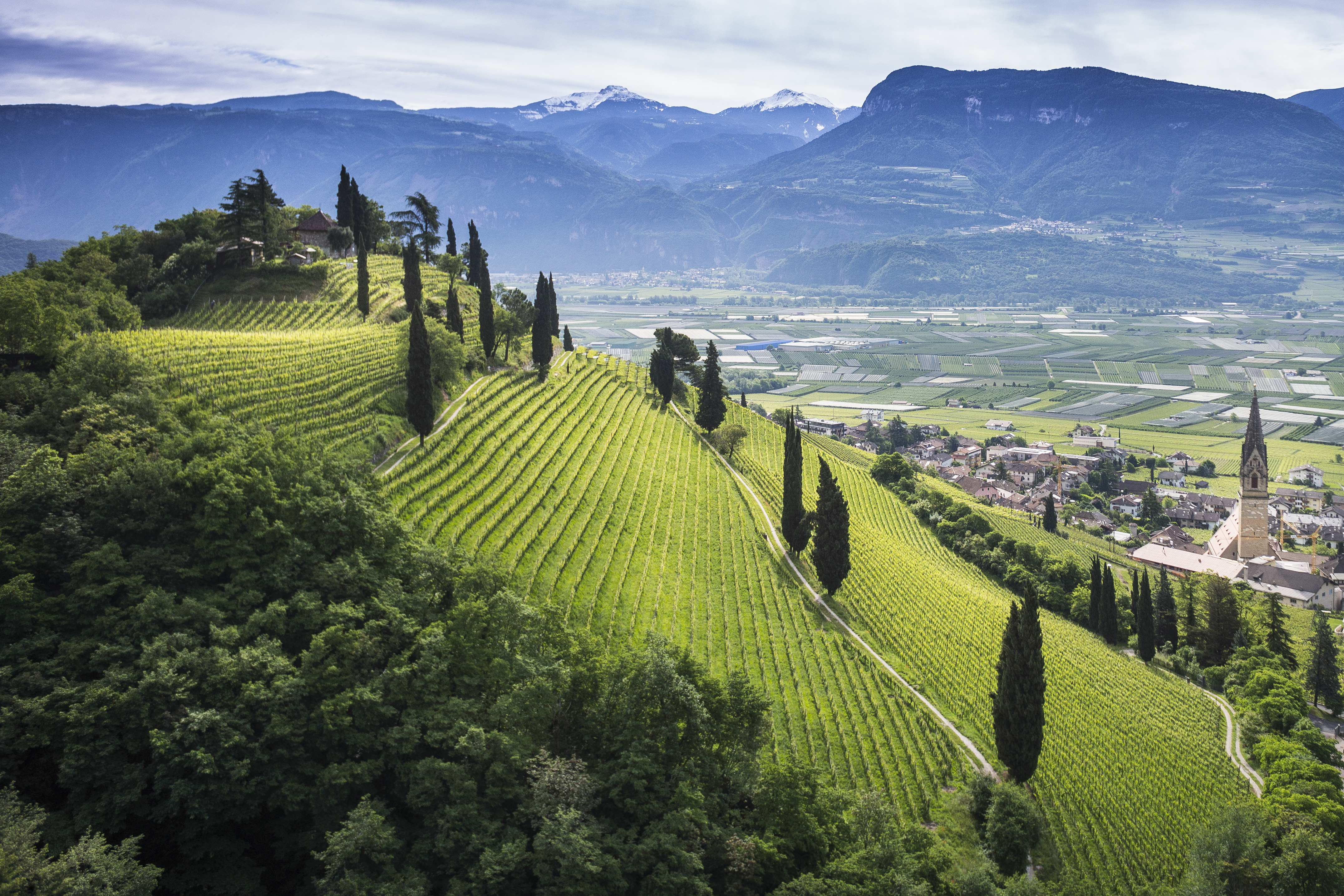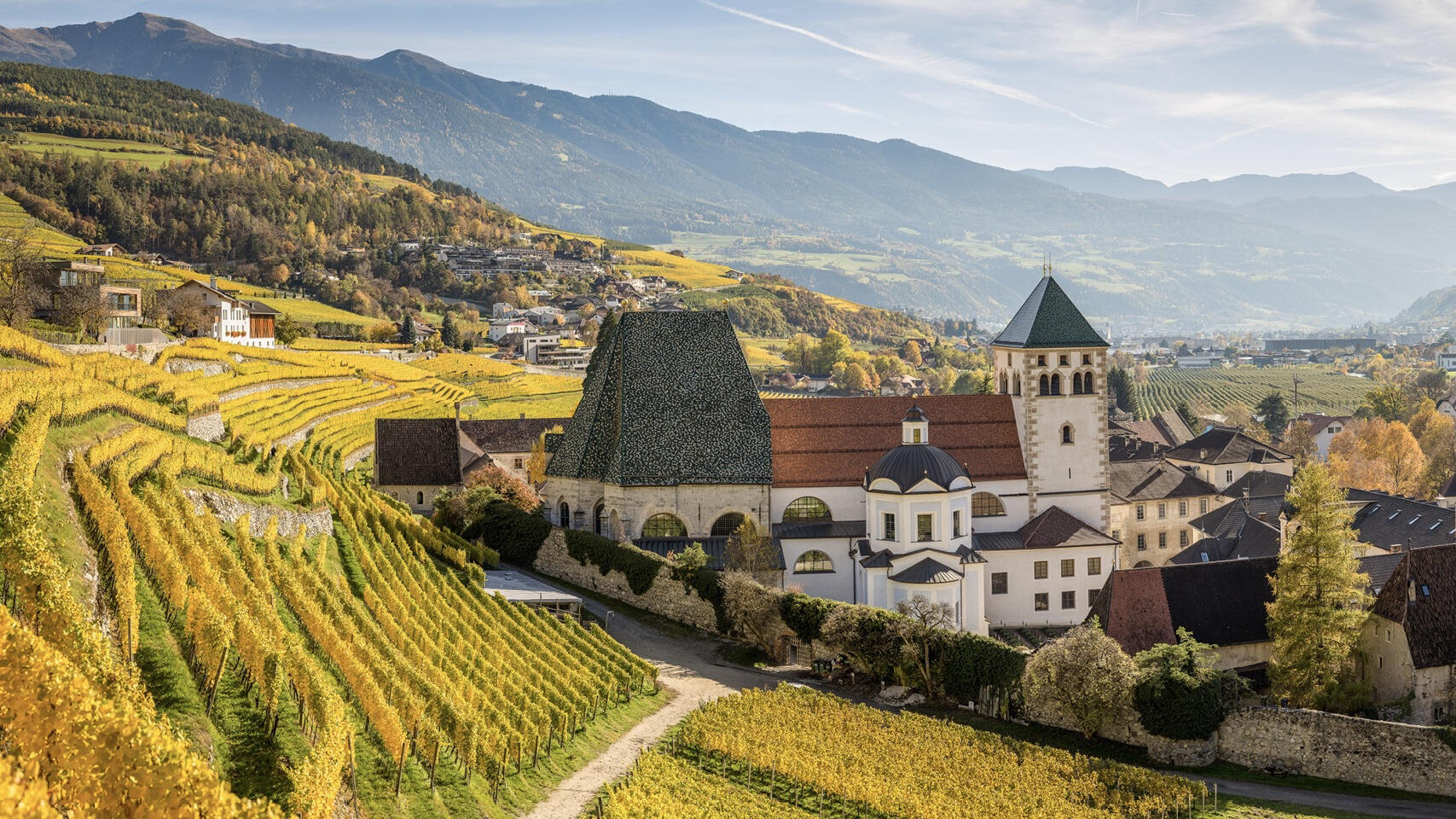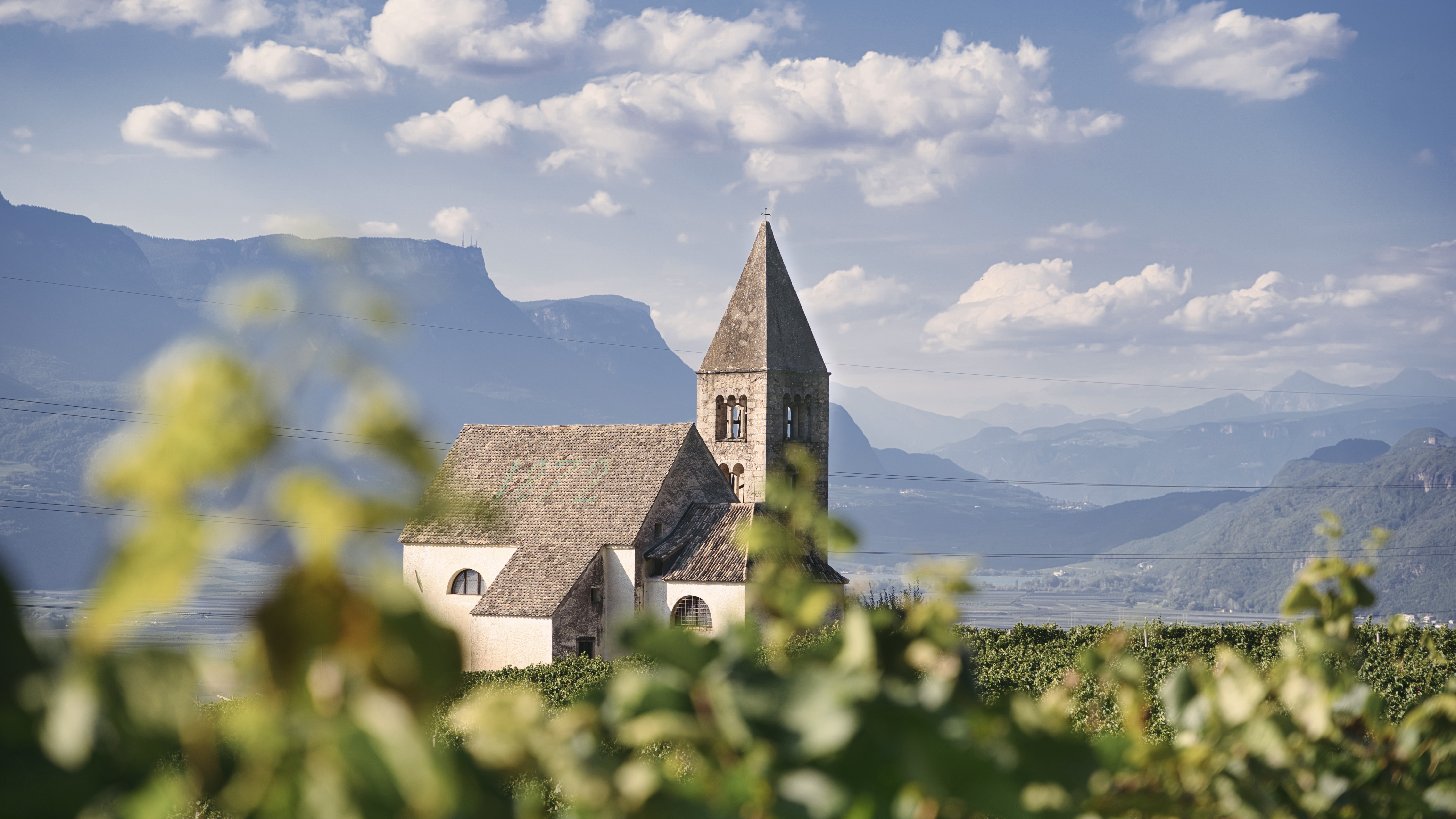Viticulture & Winemaking
Winemakers transport us to their wineries and vineyards to explain how terroir and winemaking create these unique wines found nowhere else on Earth.
Dive deep into some of the most important grape varieties in Alto Adige and the expressive wines from this diverse region.
Gewürztraminer: Learn what makes Alto Adige Gewürztraminer unique and why it's the next grape you have to try.
Pinot Grigio: Discover how to make age-worthy Pinot Grigio and how it compares to other styles worldwide.
Schiava (Vernatsch): Known as the lighter red from Alto Adige and often making easy-drinking wines, learn how winemakers create age-worthy, complex Schiava wines.
Lagrein: The robust and tannic red from Alto Adige, related to Syrah, producing powerful and age-worthy wines. Learn what makes this variety unique and the right place to find it.
Gewürztraminer
Gewürztraminer is one of the most aromatic and perhaps misunderstood varieties. With heady notes of rose, ginger, honey, and quince, Gewürztraminer is most at home in Alto Adige.
We spoke to Elena Walch, owner of Elena Walch winery, about what makes Gewürztraminer in Alto Adige unique and why it’s a variety you need to taste to understand.

What makes Gewürztraminer special and what types of soil or terroir does it do best on?
Gewürztraminer, is one of the oldest and most noble grape varieties in the world and hence, not surprisingly, it thrives very well on calcareous soils, like most great wines do. Combined with some loamy soils, it seems to have found its ideal home right in Tramin (Termeno).
Elevation wise, we tend to not go very high, in fact, Gewürztraminer seems to do very well on medium elevation at around 400 m. What is key are the temperature fluctuations between day and night, which make Gewürztraminer complex and ageworthy.
In fact, in Alto Adige we are able to easily mature the full spectrum of its primary aromas, yet retaining the acidity. This unique macroclimate combined with calcareous soils contribute to the minerality and salinity that make our Gewürztraminer distinct.
Not everyone is a fan of Gewürztaminer - what would you say to convince them it's a fantastic grape?
Gewürztraminer has different expressions in the various wine regions where it is grown. As far as Alto Adige is concerned, we produce a dry style. While on the nose, we aim for those pretty aromatics, on the palate, exotic fruit, lychee, and a fascinating spiciness come through.
However, the acidity cuts right through and leaves you with a refreshing and dry finish. This makes Gewürztraminer a fun variety to pair with many different kinds of foods: from aged cheeses to the Asian spicy cuisine or seafood cooked or even raw foods.
Gewürztraminer is also a very age-worthy variety, and you will be surprised how the aromatics change over the years and develop into aromas of dried herbs, orange peel, and even petrol characteristics.
So, whoever is looking for phenomenal aromas, which really cannot be found in any other variety, will love this grape. It's the aromatics that makes this variety unique and special!
What do you do in the cellars and the vineyards to make excellent Gewürztraminer?
Certainly, it all starts in the vineyards, and the quality is made there. Hence, identifying the right plot is key. Doing a green harvest at veraison is important as low yields are essential in order to have a good concentration of aromatics in the grapes, which are certainly all picked by hand.
Before pressing and in order to extract even more aromas from the skins, the crushed berries are cold macerated for about 6 hours. Afterward the juice is clarified by refrigeration and natural sedimentation. Fermentation is activated using selected yeasts, and the temperature is controlled at 18°C in stainless steel only. The young wine remains on its lees for several months, this to increase the body and mouthfeel of the wine.
Pinot Grigio
Pinot Grigio often gets a reputation of being a bit boring, but that’s not the case in Alto Adige. The wines here are structured, textured and show an aromatic side not seen anywhere else.
We spoke to the winemaker at Abbazia di Novacella, Celestino Lucin, about the perfect terroir for Pinot Grigio, and what sets Alto Adige Pinot Grigio apart from the rest of the world.

What types of soil or terroir does Pinot Grigio grow best on, and what makes Pinot Grigio unique?
Pinot Grigio is a very unique variety, as it accurately reflects the terroir where it is grown. This allows one to make many different styles of wines from this grape. In addition, it is a perfect variety to combine with food as it allows a lot of different pairings.
For us, Valle Isarco is ideal for the cultivation of this grape variety, as you have a cool climate and light soils which gives rise to fresh and fruity wines with a vibrant acidity.
How are the different styles (age-worthy vs light and easy drinking) of Pinot Grigio produced in the vineyard and in the winery?
We produce 2 different styles of Pinot Grigio. The classic Pinot Grigio tends to be more light and easy drinking. It is mostly aged in stainless steel and is a wine to be drunk within the first five years.
Then we have a more complex Pinot Grigio. The grapes come from the best vineyards with the best expositions and lower yields. It is completely aged in wood, half of the wine in big oak casks, half of the wine in French barriques. After 10 months on the fine lees, the wine is bottled and aged for two more months in the bottle before release.
Besides the primary aromas the wine gets a lot of structure and complexity coming from the barrel aging. We think that Pinot Grigio often is an undervalued variety as most of the Pinot Grigio is just an easy drinking wine. But if planted in the right spots, the wines can have great complexity.
How does Pinot Grigio compare in Alto Adige to other Pinot Grigios found around the world?
In comparison to most of the Pinot Grigios from Veneto, the wines from Alto Adige generally are more structured and fresher with a higher acidity. They can be very complex and elegant. This is due to lower yields, cooler climate, and mostly very good expositions on the hillsides.
In comparison to Alsace, the Alto Adige Pinot Grigio style is more fruit-forward and points more on the freshness and on the crispness, while Alsace is more structured and lush.
Schiava/Vernatsch
Schiava, also known as Vernatsch, is known as the lighter, easy going red wine native to Alto Adige, with red fruit and violet aromas.
We spoke to winemaker Gerhard Kofler, of Cantina Girlan, about how Schiava can also produce really age-worthy and interesting wines too.

Why is Schiava unique and what terroir does it thrive on?
From a historic point of view, Schiava is Alto Adige’s signature grape variety covering more than 80% of the region’s vineyards until the 1980s. Today, its area has decreased significantly, but the most important production areas remained, such as the sites Girlan and Gschleier.
Generally, the aim in the production of high-quality Schiava is to keep the yields low and to produce small bunches with small and extract-rich berries. Therefore, we find the most interesting results for Schiava on morainic and poor soils at an altitude of 450m a.s.l. (~1,500 feet). The richness of extract, as well as lively fruitiness, can be found on slightly acidic soils, for example, the vineyards of Gschleier.
How are the different styles of Schiava produced in the vineyard and in the winery?
As with every variety you can produce age-worthy as well as easy-drinking wines. The key to produce age-worthy wines is to find the right soil that gives small bunches and low yields.
Moreover, the age of the vines is highly important as well as the aging. Schiava is a very elegant and rather light-bodied wine, the use of oak shouldn’t be too dominant. However, by aging in big oak barrels, Schiava gains complexity and structure which is crucial for its longevity.
When considering these most important factors (soil type, yield, ripe fruits, and aging) Schiava can be one of Alto Adige’s most interesting varieties when it comes to longevity. In fact, we have bottles of “Gschleier Alte Reben Vernatsch” that go back until 1976 and still show fantastic freshness and liveliness.
Lagrein
Lagrein produces Alto Adiges most structured, deeply coloured and age-worthy red wines with blackberry and violet notes. Another native grape, and unique to Alto Adige, we found from Florian Gojer, winemaker at Glögglehof, about where to grow this heat loving variety, and what is needed in the winery to make it great.

What makes Lagrein special and what types of soil or terroir does it do best on?
The first thing that comes to my mind of course is its dark, almost black colour that always impresses at the first sight. Lagrein is a very characterful variety.
Lagrein is an indigenous variety of Alto Adige and that is why the grape variety has an inestimable value for us, because it is strongly connected with our territory and it is also a good companion for some typical dishes of our cuisine.
But to be able to exploit the full potential of the variety, certain growing conditions are key:
Profound alluvial soils with alternating sandy and gravelly layers and with predominantly Porphyry (vulcanic) rock. The soils should be very rich and well supplied with water. Lagrein needs very warm growing conditions too, to get fully ripe and soft tannins.
All these conditions can be found in the Bolzano basin, where Lagrein finds a perfect home.
What's something you want everyone to know about Lagrein?
This indigenous variety gives very characterful wines that impress more and more red wine lovers all over the world. In the last years more single vineyard wines and special selections were produced, in order to show the full potential of this great red variety. 10% of the DNA is identical with the much more famous Syrah, so go get some Lagrein and enjoy this precious variety!
What do you do in the cellars and the vineyards to make excellent Lagrein?
“Lagrein is very vigorous and we try to calm it down as much as possible, to have smaller berries and clusters that give higher intensity. It also helps to have a lower yield in a natural way and we no longer have to intervene so strongly through green harvesting.
In the cellar we do try to get as many whole and intact berries into the tank; this gives us very precise and soft tannins and higher fruit intensity. It also helps to push the wines into a more elegant direction, which I personally like a lot. Because Lagrein sometimes, when it’s over extracted or planted in the wrong areas, can be rough and rustic. Barrel aging with the right amount of new oak helps to soften the tannins even more.